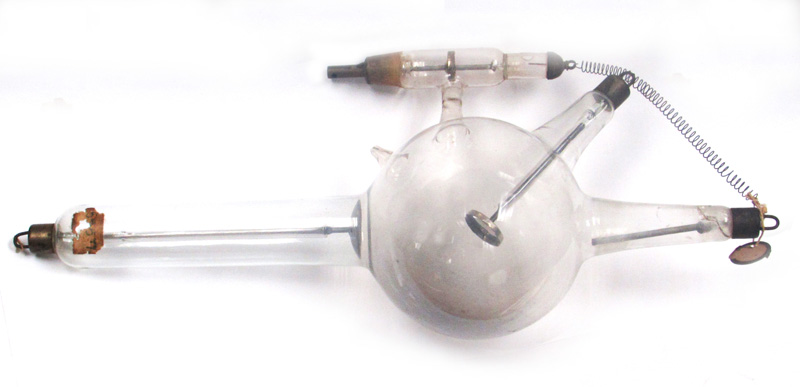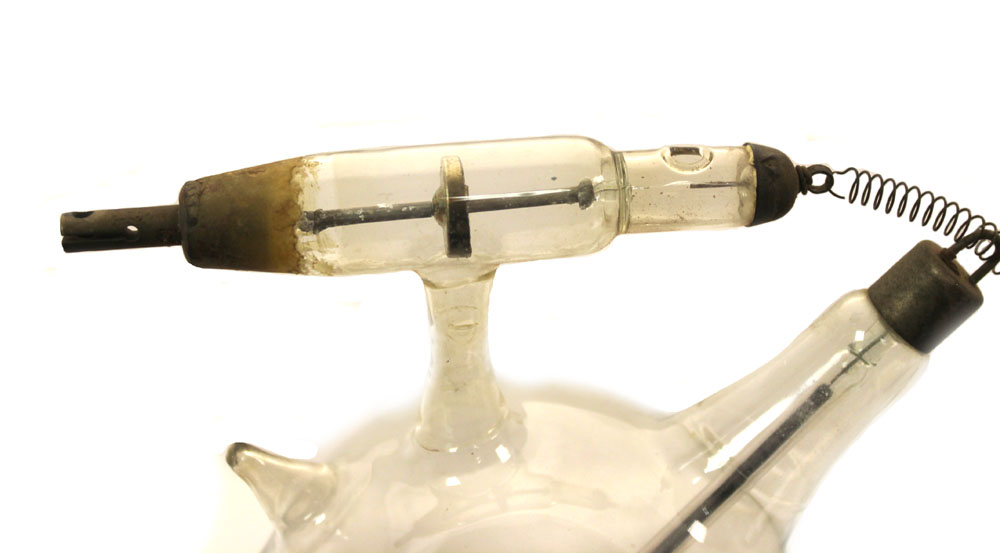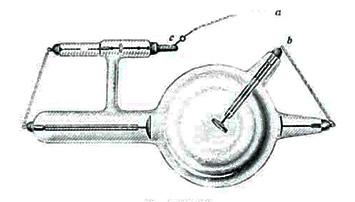Pressler (possibly Schilling) Cold Cathode X-Ray Tube (ca. 1910-1915)

Since there are no marks anywhere on this tube, it is a bit of a mystery. Nevertheless, the design suggests that it wasn't manufactured much later than 1915 and that the manufacturer was probably Otto Pressler.
As seen in the photo, the focused aluminum cathode is located inside a glass arm where the latter connects to the left side of the spherical bulb. The anode is the aluminum rod enclosed by the glass arm attached to the right side of the bulb. The third electrode, the anticathode, enters at a 45 degree angle from inside the short glass arm attached to the upper right side of the bulb.
The target is the circular platinum disk in the center of the bulb (at the free end of the anticathode). Since it lacks any type of heat sink, this target is unsuitable for prolonged operation with a high current. Due to the target's low mass, it would be referred to as a “light anode”—a potentially confusing term because it is not the anode.
Unfortunately, the glass arm to the right is damaged with the result that its anode hangs down, barely holding on. Some of us know the feeling.
Despite this damage, the tube is a welcome addition to the collection if for no other reason than the fact that it has a really neat and mysterious (at least to me) regulator. The latter is the "T-shaped" glass appendage sticking out the top of the tube that would supply additional gas when the vacuum inside the tube became too great. The circular metal disk in the regulator (seen from the side in the photo below) contains the material (probably mica disks) that would provide the necessary gas when it was heated.

What is most interesting is the fact that the right end of the regulator (as seen in the photo) consists of a small glass chamber that is open to the atmosphere. Inside this chamber is a fixed spark gap the right terminal of which is electrically connected to the anticathode and anode. Now how this is supposed to work is a mystery to me.
The adjustable lever (wire) that would normally be connected to the negative terminal of the regulator is missing. If the lever were present, its free end would terminate near the electrical connector for the cathode to form a spark gap—necessary if the regulator were to function automatically.
It seems that the rights to the regulator (DRGM 293815) were awarded to Franz Schilling in 1906. For a short period, ca. 1906-1910, Schilling published his own catalog of X-ray tubes. As you would expect, many of these tubes employed Schilling's regulator. It is interesting to note that some of the figures (and text) in the Schilling catalog are identical to those in a 1914 catalog published by Otto Pressler. The latter was a large company based in Leipzig, Germany that produced vacuum tubes of various types (e.g., Crookes tubes, Geissler tubes) for academic institutions. Pressler, probably after purchasing Schilling's company, began producing X-ray tubes sometime around 1910. Although none of the tubes in these catalogs is a perfect match for our tube, there are so many similarities that it seems reasonable to believe that ours was either a "Schilling tube" or, and this is the more likely possibility, a "Pressler tube." Curiously, Schilling worked in the same building in Gehlberg, Germany where Gundelach tubes were manufactured.
The following is a very rough "translation" of the text in the Schilling and Pressler catalogs that describes the regulator. I have tweaked this "translation" to make it somewhat clearer than the original text.

The fact that all X-ray tubes lose air (become harder) as they are used has led to the development of various devices [regulators] that regenerate this air. It is preferred that these work safely and quickly without any special means (such as heating by means of a flame, etc.) and that they can be used as often as necessary. Such a device is described by D.R.G.M. No. 293815.
It can be used either automatically or manually. If the device is to act automatically, it is necessary to set the tip of the wire (a) at an appropriate distance from the electrical connection to the target (b). The gas will be regenerated during the operation of the tube when a spark travels across the gap between a and b. Depending on the distance between a and b, the tube will become soft or hard. For an X-ray tube that is 30 to 50 cm long, this distance will be 5 to 7 cm if a soft tube is desired and 10 to 12 cm if a hard tube is desired.
If the automatic regeneration is not desired, the screw must be sufficiently tight at c for the wire to hold its position, but not so tight that the wire can't be moved up or down. When regeneration of the gas is desired, move the wire with a wooden or glass rod until a spark travels from a to b. Immediately return the wire to its original position (where the distance from a to b is too great for a spark to occur).
There are a couple of things worth noting about the above figure (from the Schilling and Pressler catalogs). First, and this is a minor point, the regulator is attached to the cathode arm rather than the bulb. Second, the end of the regulator containing the spark gap is connected to the cathode whereas it is connected to the anode in our tube. Why it is connected to the cathode in some Schilling and Pressler tubes and connected to the anode in other tubes is unknown.
Size: Approximately 4" diameter bulb, 13" long
I would like to thank Udo Radtke for his invaluable assistance in providing much of the above information.
